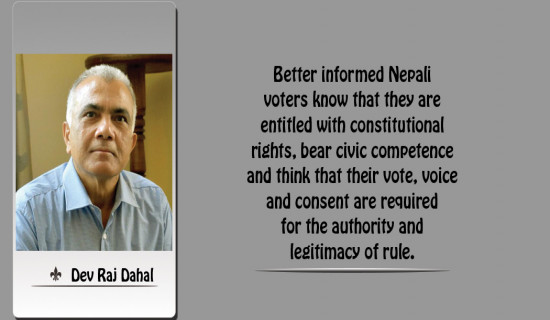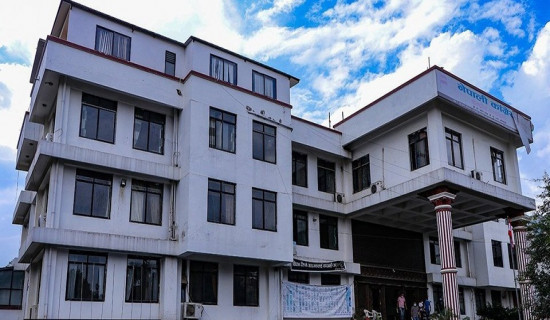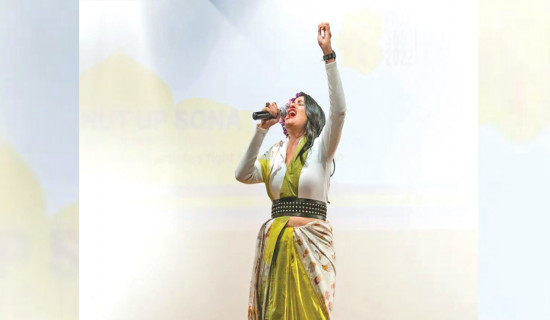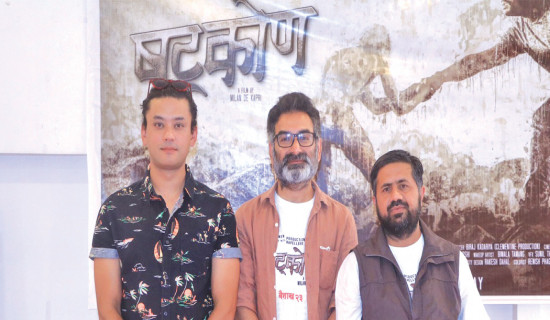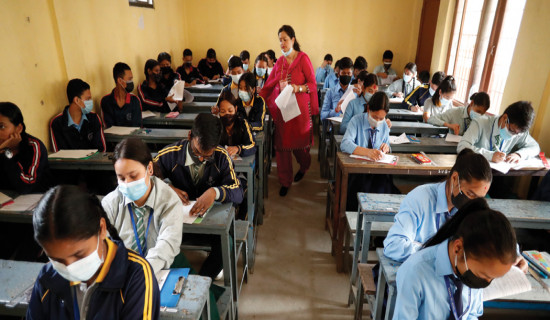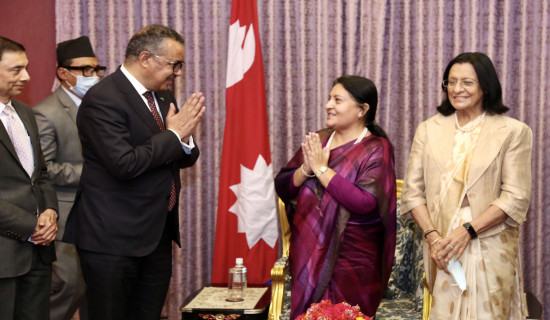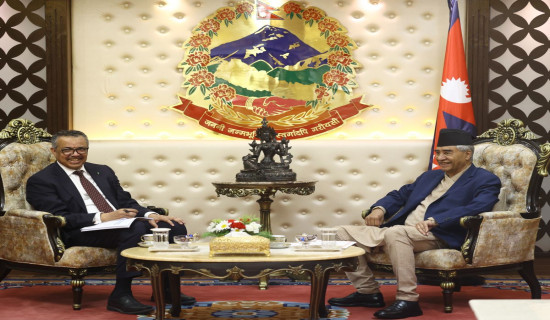- Wednesday, 5 November 2025
From Parochial To Reflective Citizen
Dev Raj DahalA shift from ‘parochial,’ ‘apathetic’ to ‘reflective’ and ‘engaged citizens’ has become the order of the day. The central pillars of multiparty democracy -- political parties, cultural industries and educational institutions-- are given primary accountability for educating youths to become good, reflective and engaged citizens in their communities and do essential services in the entire life of the nation. Nepal’s general voting turnout stands around 70 per cent which is a good sign of public participation. But it has not made them fully conscious of their rights and duties, constitution and the operation of political power, political parties, leadership and interest groups and nurture civic competence to shape public policies. Plural media are, therefore, spreading information and knowledge about democratic principles, institutions and orientation and telling Nepali voters to seek the rationale of their vote in tangible terms. The average invalid voting turnout hovers about three per cent. This mass of populace does not know how to vote. Voters’ education can spur a patch of light in a vast darkness of ignorance and reduce invalid voting. A huge swath of migrant workers abroad also finds it expensive to return home just for voting. They and some others form “absentee voters” as they are dictated by the daily necessity to earn their living, not democratic choice. Apathetic votersThere are anti-system radical political parties whose revolutionary dream disenfranchises their members from voting. In Nepal, apathetic voters are huge as they do vote but do not know the weight of rational voting informed by critical knowledge of issues, candidates and shaping prudent opinion to influence public policies. As a crowd of innocents, they loiter in the fringe of politics and apply primitive criteria in voting.The soaring election costs in Nepal favour big parties with robust organisational muscle, business financiers, media control, large membership and muscular means prompted by the distorted notion of politics to get rich, not engage in constructive politics of public services. If voters are given civic education in no way they are prompted by short-term profit, impulse or bandwagon effects spurred by mass show of party’s power, media glittering image of personalised leaders and flood of unrealisable promises of moon and stars. In Nepal, this sort of education has to be ratcheted up by the cultural industries, educational institutions, party schools and even civil society. Otherwise, they do not care who rises to power and, thus, rejoice all regimes - democratic, authoritarian or totalitarian party control of polity and the state. Nepal’s raucous political evolution has seen party transformation into a catch-all type without renovation of the civic culture of leaders and their self-indulging bent to revise the rules of the game beyond constitutional imperative. The reasons include simulation of managerial form of politics that applies business logic of transactional leadership, not transformational and value-based ones, and the homogenisation of horizontal left-right-centre leadership culture and growth of a new frame of vertical top-down politics indivisible from a division of power.The fresh hope for democracy deepening lies in the growth of reflective, active and engaging citizens. They require gaining ample civic knowledge, thinking for selves, forming opinions and engaging in wise choices about leadership, organisation, policy, resources and action. This allows voters to control the leaders monopolising political and economic power and enforcing accountability to their promises and mandate. Reflective citizens require constant learning about the changing context and application of civic awareness, skills and temperament to improve participatory political process to safeguard the nation’s civic culture. They offer scope for critical judgment of leaders’ performance and contribute to political reform, participation and rational leadership growth reflecting rational pursuit of a balance between private interest and common good. Better informed Nepali voters know that they are entitled with constitutional rights, bear civic competence and think that their vote, voice and consent are required for the authority and legitimacy of rule. They even revoke their consent if they find their leaders withered from the sensitivity to general public and national interests.It is vital to awaken the large mass of apathetic Nepali citizens from their doctrinaire snooze, blind faith and conformity to every type of leader unresponsive to their own promises and enable them to judge what is right and good from their lived experience and normative and constitutional standards. The irony of Nepali politics is the formation of a series of odd electoral coalitions of unlike-minded political brands in power, opposition and resistance riddled with obdurate logic of left, right and centre contradictions, history of betrayal of each other’s trust and justification of their entrepreneurial action in the name of doctrine of necessity to save the status quo and secure gains made so far. This has turned many Nepali voters free-floating, not party or ideological curve and hollowed out the utility of multiparty-based democracy where parties become instruments of winning and governing power and shaping public policy outcome. Voters’ ultimate loyalty to leaders and their votes on the basis of primordial concerns, not partisan or ideological attachment of the values when the party was created can flag the basis of party politics and fertilise non-elected interest groups and social movements as leverage for power struggle.In a collusive nature of electoral strategy, Nepali voters’ dilemma is obvious: they detest voting candidates of other parties as per the direction of top leaders while non-voting weakens the stand of the parties they esteem. In a fissiparous political environment, Nepali voters thus face a paradox: the swelling cost of casting ballots outweighs the likely benefits where even the elected leaders find the execution of mandate difficult as political struggle is pivoted not between economic class or policy alternative but based on the fulfilment of emotional identity recognition of voters. The class approach of party struggle has virtually disappeared in Nepal thus radiating a shift of politics from ideology to sociology.In a nation of heterogeneous populace, the future electoral politics of Nepal will be marked by an oscillation from one phase of unstable equilibrium to another among the contending electoral coalitions, some even acting as free-riders and switching sides based on opportunity as past electoral behaviour eerily suggests. Only reflective and engaged citizens have the ability to act in accordance with their conviction and conscience as well as constitutional duty and personal will. The “categorical imperative” formulated by Immanuel Kant calls for leaders to treat citizens like themselves, not manipulate for instrumental purpose either through indoctrination, false promise, financial incentive, coercion, false media image, or anecdotes expressed in soundbites, not a clear vision of national building. The instrumental rationality rooted either in bureaucratic politics of status quo, electoral strategy of collusion, de-ideologised polarisation, power of money to influence politics or media culture of ideological conformity, etc. suppress democratic impulse of Nepalis for self-governance. Both leaders and voters require an understanding to use their freedom of choice and behave as per their reciprocal needs. Nepalis can come together to vote for self-rule if social good serves as an incentive for them granted by the state and constitutional bodies, the government controls the vices of electoral malpractices and civil society offers civic education to politicise them, provide social mobility and agency for collective action. Social inclusion, social justice and social security are precisely designed to rectify the historical injustices by compensatory redistributive measures so that reflective, active and engaged citizens can regularly socialise, articulate demand and mobilise other types of voters for democratic dividends to enrich the quality of democracy.Each of Nepali leaders, elevated into iconic status by their media and cadres, preach party’s separate manifestoes even in a condition of electoral alignments, gather followers and disagree with each other on ideology, sociology and history of party formation. The supporters split from each other and indulge in quarrel and mutual accusation, endorsing their leaders’ differing versions of ideas about formulating electoral strategy and help them monopolise leadership in each election, despite the temptation of Nepali voters to defeat the incumbent party in power on each occasion. HiatusIn Nepal, the old system of politics has not been able to manage the influence of media, money and technology thus revealing a hiatus between what voters want, what they think about politics and how it operates to keep the status quo tether. This hiatus is prompting them to actualise constitutional possibilities for a shared form of democratic public life, not a zero-sum game. This, however, demands a fair equality of opportunity in elections so that political leaders can be smoothly circulated in the infrastructures of democracy and the political system, each pins faith in the values, principles and institutions of constitution and abides by its rules as a highest average utility to them. The parochial, apathetic and alienated voters must be educated about the principles and practices of democracy, opportunities and political choices so that they become stakeholders and find a reason to be committed to participate in electoral politics.(Former Reader at the Department of Political Science, TU, Dahal writes on political and social issues.)
Three killed in road accident
Three persons died on the spot when two motorcycles met with an accident at Malekpur of Rajgadh Rural Municipality-5 of Saptari today.
First international flight to Bhairahawa by Jazeera Air
Jazeera Airlines will be the airline's company to make the debut international flight to the newly opened Gautam Buddha International Airport in Bhairahawa.
NC Central Work Performance Committee meeting tomorrow
The meeting of the Nepali Congress Central Work Performance Committee is scheduled to be held on Saturday.
Film Southasia kicks off
By Aashish MishraLalitpur, Apr. 23: South Asia is an incredibly diverse region. It is home to eight countries, one-fourth of the world’s population, many religions, countless cultures and an incomprehensibly large number of languages. But from this diversity stems a unique unity – a Nepali looks no different from a Bangladeshi, an Indian will be able to convey himself quite understandably to his Pakistani peers and hardly will there be a South Asian ear that will not relate to the experiences an Afghan may share.South Asia is united in its diversity and diverse through its unity – an abstract concept at the first glance but one evidenced by the stories being screened at the Film Southasia (FSA), the biennial festival of documentaries that opened in Lalitpur on Thursday. The four-day festival is scheduled to showcase 71 films from eight countries of the subcontinent at Yala Maya Kendra and Patan Secondary School, Patan Dhoka.The festival, which is celebrating its silver jubilee this year, is an important platform that highlights the importance of documentaries in the sphere of public media, said Minister for Communication and Information Technology Gyanendra Bahadur Karki, during the formal opening of Film Southasia at Kamalmani Theatre on Thursday. “Documentaries provide a window into the challenges of society and by showing them to an audience, FSA offers us all a chance to understand South Asia,” he said.Minister Karki hoped the festival would convey a message to the region that Nepal was open for tourists and reiterated the government’s unequivocal commitment to democracy and the freedom of expression. “The Government of Nepal is committed to maintain Nepal as an open society where ideas are not bound and expressions are not restricted,” he said to a room that rung out in applause.Nepal has hosted all 13 iterations of the festival over its 25-year history. This year, in the words of FSA director Mitu Varma, the festival brings forth a vast range of stories and subjects to celebrate the fact that we all have lived to tell the tale of the perilous peak of the pandemic, to bear witness to the extraordinary times and retained in the vast diverse population of the region, the empathy to tell stories with optimism and faith in the essential humanity inherent in all.FSA Chairman Kanak Mani Dixit also spoke on the occasion and exclaimed dissatisfaction with the fact that the term ‘South Asia’ did not make anybody nervous. “This is a failure on our part,” he said. “Because South Asia is not a romantic notion, it is a notion for social justice, for inclusion. It is a concept that transcends the nation state.”Dixit also called Kathmandu the present capital of South Asia and building on Minister Karki’s point about open society he stressed, “Nepal must remain open, not just for the sake of Nepalis but for all of South Asia.”During his remark, Dixit noted that “South Asia is here.” Looking at the filmmakers and audience gathered at Kamalmani Theatre on Thursday, one would certainly agree with Dixit.
Karma becomes investigative journalist in Shatkon
By A Staff ReporterKathmandu, Apr. 23: Actor Karma said that he did not come to become a star in Nepali cinema, therefore, he has more choices, he said. Speaking at a press meet organised in the capital on Thursday to promote Shatkon, his film, he said, “I did not come to the cinema to become a star. I don’t even want to be a star. The star is to shine. It’s a different matter. For me, movie is an art and I am more concerned to present my art skills through movie rather than trying to be a star of Nepali cinema industry.” The lead actor Karma is playing the role of an investigative journalist in the film. Directed by Milan De Kapri, the film is produced by Biraj Kadariya. Speaking at the press meet, director Kapri said that it was a psychological thriller movie made by a team of youth. “We have tried to make it different from other movies produced in Nepal. My movies do not have the same actors fighting a while ago and singing and dancing after a while. It has only the songs that fit the story. Therefore, we have tried to make it a different movie,” said director Kapri.The movie, produced under the banner of Clementine Production and Travelers Crew Films, will be released in cinemas across Nepal from May 6. The production team said that they are ready to release the film as they are waiting for its release before the COVID-19 pandemic hit Nepal. Apart from Karma, actors including Bholaraj Sapkota, Lokendra Lekhak, Suyasha Adhikari, Biraj Kadariya, Shishir Limbu Wanem and child actor Asim Lama have done the film. Mahesh Dawadi has written the dialogue of the movie which has the story and script of Shishir Limbu Wanem. The cinematography of the film is directed by Angchen Lama while Sagar Khanal has edited the film.
CDS provides wheelchairs to children
By A Staff ReporterKathmandu, Apr. 23: Child Development Society (CDS) organised wheel chair presentation ceremony in the presence of Agni Prasad Sapkota, Speaker of House of Representatives, in Kathmandu, recently. Speaking on the occasion, Speaker Sapkota lauded the role played by the CDS for the continuous service towards children and their rights. Sapkota also committed for necessary assistance in the days to come for the welfare of children. On the occasion, in assistance of ‘Wheelchairs for Kids-Australia’, 150 sets of wheelchairs were handed over to CDS to be provided to differently abled children. Consulate General of Nepal in NSW, Australia, Dipak Khadka, Member of Legislative Council (MLC) Australia and chairman of ‘Wheelchairs for Kids’ Shaoquett Moselmane were present on the occasion. On the occasion, Moselmane said that the wheelchairs were provided for those children who need support to walk. Uddhab Kharel, mayor of Budhanilkantha Municipality, thanked CDS for providing such assistance to differently abled children.
SEE held on first day peacefully
BY A STAFF REPORTERKathmandu, Apr. 23: The Secondary Education Examination (SEE) of compulsory English concluded peacefully across the country on Friday, the National Examination Board (NEB) informed.The SEE of the academic session 2078 has kicked off from Friday.Arjun Rayamajhi, Controller of the SEE, informed that the examination of compulsory English was held in a peaceful manner on the first day today.The NEB stated that a total of 514,967 examinees are appearing in the examinations this time.The answer sheets will be collected at the Education Development and Coordination Unit (EDCU) of the concerned district and will be sent to answer sheet checking centres at different places, Rayamajhi saidMeanwhile, according to our Bajura correspondent, a total of 3,188 examinees, including 1,633 boy and 1,555 girl students of 61 community and four private schools appeared in the examination in the district. Of them, 78 students, 31 boys and 47 girls, appeared in the grade upgrading examination.According to the Education Development and Coordination Unit, Bajura, 3,188 students appeared in the SEE from 15 examination centres of the district.Harka Bahadur Singh, chief of the Education Development and Coordination Unit, Bajura, said that three to five security personnel have been deployed in each examination centre. Similarly, according to our Humla correspondent, four candidates with disabilities have participated in the SEE in the district. Three of them are boys. Superintendent of Mansarovar Secondary School Amar Bahadur Shahi said that three candidates with sight impair participated in the examination. Those students were studying in Balmandir Secondary School. Meanwhile, one student with poor eye sight took the examination from Balmandir Secondary School.According to Tilak Bhattarai, head of the Education Development and Coordination Unit of the district, more than 94.50 per cent candidates are participating in the examination from all the six examination centers of the district. A total of 1,146 candidates have applied for the SEE examination while only 1,083 candidates have appeared in the examination of the first day. The number of girl students participating in the examination is 521 and the number of boys is 562. The SEE will conclude on May 3.Meanwhile, the NEB has also published the examination routine of grade 11 which will begin from June 12.
Warmer Summers Threaten Antarctica’s Ice Shelves
Jennifer ArthurDuring the Antarctic summer, air temperatures get warm enough to melt snow and ice on the surface of the great ice sheets that make up around 99 per cent of Antarctica. This melted water collects to form thousands of lakes around the edges of this vast continent. Most of these lakes form on gigantic platforms of floating ice called ice shelves, which extend out from the continent into the sea.Lakes forming on the surface of these ice shelves can sometimes cause them to break up. The most famous example is the collapse of Larsen B ice shelf on the Antarctic Peninsula, which shattered entirely over a matter of weeks in 2002.HydrofracturingSatellites recorded the appearance and drainage of thousands of lakes on Larsen B’s surface before it broke up. Scientists believe meltwater from these lakes widened and deepened cracks and crevasses within the shelf in a process called hydrofracturing.Ice shelves act as doorstops, supporting vast masses of ice known as glaciers that lie further inland. But if hydrofracturing forces them to break up, these rivers of ice that feed into the ice shelf flow faster into the ocean, contributing to rising sea levels.Scientists have recently found that lakes are more extensive around the Antarctic ice sheet than previously thought. Endurance swimmer Lewis Pugh even swam one kilometre through one of these lakes in 2020 to raise awareness of climate change. But how much does the meltwater stored in these lakes vary between years, and how is this linked to climate conditions? This is something my colleagues and I have explored in a new study, published in Nature Communications.Our research uncovers for the first time how meltwater lake coverage and volumes vary between years around the whole Antarctic ice sheet. We analysed over 2,000 satellite images of the East Antarctic sheet – the world’s largest – to record the changing size and volume of these lakes over the past seven years.Until now, observations of surface meltwater lakes on the East Antarctic ice sheet were relatively scarce and their year-to-year changes were largely unknown, making it difficult to assess whether some ice shelves were close to breaking up under the effects of climate change.We found that total lake volume varies between years by as much as 200 per cent on some ice shelves and by up to 72 per cent across the entire ice sheet, with large differences between ice shelves. Across the whole ice sheet, total meltwater stored in lakes peaked in 2017. That water could have filled about 930,000 Olympic swimming pools. Melting at the surface of the sheet doesn’t just form lakes: the water also seeps into air spaces in the layers beneath the surface, where it freezes as temperatures get colder. These layers, called firn, are made up of old snow that has not yet been compressed into ice.If more melting occurs than snowfall each year, air in the firn becomes replaced with refrozen meltwater. When that happens, meltwater forming the next summer is forced to collect on the surface as lakes. The more surface melting there is, the more the firn gets saturated like a sponge and so the more lakes form on the surface, increasing the risk of fracturing.To investigate lake variability between years, we ran model simulations of firn air content, surface melt and runoff on Antarctic ice shelves where lakes form. We found that across the whole ice sheet, summer air temperatures and the amount of air in the firn are important factors affecting the total area and volume of meltwater lakes. We’ve noticed on satellite images that on some ice shelves lake coverage is already expanding into regions vulnerable to fracturing.Lake formationInterestingly, we found large differences between where we’ve observed lakes in satellite images and the amount of meltwater that can form lakes predicted by our models. This means local climate conditions are more important than we thought in predicting surface melting and therefore lake formation. Our climate models still need refining to allow these processes to be fully captured to better predict future surface meltwater around Antarctica.In a warming world, these lakes are likely to continue to spread onto ice shelves that are vulnerable to breaking up. Our work is a step forward in understanding not just where lakes are forming now across the whole ice sheet, but what controls the way they change every year. This is key to predicting which ice shelves are most at risk of collapse, as well as for improving model projections of Antarctica’s contribution to sea-level rise.(Jennifer is a PhD student in Cryospheric Remote Sensing, Durham University, UK.)-- theconversation.com
Relevance Of Earth Day
Aashish MishraFriday, April 22, was Earth Day – the 52nd Earth Day to be exact; the 52nd year global leaders came together to pay lip service to the cause of environmental conservation, pollution reduction et cetera and et cetera then promptly went about forgetting it and focusing on the “more pressing issues” at hand.It has been like this from the start. There has always been something more pressing and more urgent than our planet that required our attention. Even in 1970, on the day of the very first Earth Day, American investigative journalist Isidor Feinstein Stone criticised Senator Gaylord Nelson, the person who launched Earth Day, as a man propagating a con. “This is a beautiful snow job,” he said, “Designed to distract attention from government military and spending policies.”“The country is slipping into a wider war in Southeast Asia and we’re sitting here talking about litterbugs.”But Nelson was not just talking about litterbugs. He was talking about the planet we all live in, the planet that is the only feasibly inhabitable world we have to date and a planet that is fast swerving toward the edge of the precipice.Policymakers at the time and now claim to stand with Senator Nelson’s view but have unfortunately seemed to internalise Journalist Stone’s opinions because, as mentioned above, they always have their hands full with something other than the foundation for the survival of our species.After the war in Vietnam, that Stone was referring to, ended, the focus shifted to the increasingly intensifying Cold War, then to the Afghanistan War, then the collapse of the Soviet Union and the integration of the post-Soviet states into the mainstream world order, then global terrorism, then the COVID-19 pandemic and now the Russian invasion of Ukraine. Meanwhile, the climate crisis rages on. The air we breathe grows more toxic by the day, the water we drink seems to have more chemicals in it than actual water molecules and the less said about the food we eat the better. Our planet is dying and it is killing us with it and yet, it is still not a sufficiently important enough issue to be prioritised by our governments and our societies.To borrow Stone’s phrase, “Our home is on fire and we’re sitting here talking about the bedbugs we think have infested our mattress.”This is a clichéd phrase but one that warrants repetition. Without Earth, there is nothing.Everything we have ever done and will ever do and everyone we have ever known and will ever know is this third rock from the sun. Without Earth, there is no us. Our planet concerns all of us and thus, all of us should work together to protect it. We are all residents of a common home that we ourselves seem hell-bent on dismantling. We must change our collective habits, if not to reverse the damage already done then to at least prevent further destruction. Bodies like the United Nations must lead international efforts and make nations do their part whether by incentives or by pressure. There is absolutely no time to lose because every second we delay is a second closer to the apocalypse.The word ‘apocalypse’ may seem like an exaggeration. Some may even call it fear mongering. But it is not untrue. We are getting a glimpse of the future that awaits us. Rains these days are either droughts or floods, hurricanes are getting stronger than ever, tornadoes are touching down in places that had never even conceived of such a weather phenomenon, let alone seen it (remember the storm that swept across Bara and Parsa on March 31, 2019?). Things are going to get worse if we do not take the right action now.
Online game leads to rape of underage girls
By Purushottam P. KhatriKathmandu, Apr. 23: Can you imagine a 13-year-old girl has been raped after getting addicted to an online ‘Free Fire game’? But this has happened in Kathmandu recently. Kathmandu District Police Office has arrested Mahesh Udas, 27, of Palpa on the basis of the victim’s complaint. According to Superintendent of Police (SP) Dinesh Raj Mainali of the Police Office, Mahesh invited the girl to come to Kathmandu from Palpa after they became friend through the game ‘Free Fire.’ A preliminary police investigation has shown that Mahesh enticed the girl with the promise of marrying her. But, instead of getting married, the girl was raped by her online gaming friend. The man was undergoing further investigation after a 10-day remand order from the Kathmandu District Court on Wednesday. SP Mainali said that the police will file a rape charge sheet against him under Section 219 of the Chapter 18 of the National Criminal Procedure Act 2017. How it happened A preliminary investigation of the police has revealed that a 13-year-old girl was raped by a young man at Basundhara in Tokha Municipality-6, Kathmandu, on April 13. According to the Criminal Code Act, adolescents under the age of 18 are not allowed to have sexual relationship even with consent. Now, actor Pal Shah is doing his time in a jail on the order of the district court for having sex with a minor girl. According to SP Mainali, Mahesh had committed the crime by pledging to marry the girl. Some time ago, the girl’s family had lodged a complaint with the police alleging that she had gone missing. After that, the Kathmandu Metropolitan Police and its subordinate police offices started searching for the girl. During the search, the girl was found at Matatirtha in Chandragiri Municipality-8, Kathmandu, on Monday this week. After finding the girl, Mahesh’s deeds were exposed during interrogation. It has been revealed that Mahesh and the girl got acquainted a year ago. The medium of their acquaintance was the ‘Free Fire’ game. While playing the game, they started talking through messenger. Not only that, their chats on mobile phones had increased, said the police. It has been revealed that Mahesh brought the girl from Palpa to Kathmandu on a motorcycle saying that they would get married on April 12. It is mentioned in the complaint filed by the victim that she was raped by him. Additional caseThis year in January, a fake Facebook account named Sangam Maharjan was used to rape a girl by establishing friendship with her. Police had arrested Sujan Shrestha, a resident of Panauti Municipality-1, in Kavrepalanchok on charge of being involved in the incident.According to the police, Sujan had initially made video calls to the girl persuading her to show her private parts and recorded the video call. He then started threatening to show the video to her friends at school and family and make it viral on social media.It has been revealed through the police investigation that she was called to meet him in an under construction house near Budhanilkantha in Kathmandu on January 11. SP Mainali said that with the increase in the use of technology and online gaming, different forms of criminal incidents are taking place in society. Lately, criminal activities resulting from online streaming game platforms, including Free Fire, has been on the rise. As a result, such apps have been banned in many countries, said SP Mainali.
Nine new cases, 25 recoveries in 24 hours
In 2,133 Real-Time Polymerase Chain Reaction (RT-PCR) tests done in the past 24 hours, a total of nine people were found infected with SARS-CoV-2, informed the Ministry of Health and Population (MoHP) in its regular update.
WHO Director General Dr Tedros calls on President Bhandari
Director-General of the World Health Organization (WHO) Dr Tedros Adhanom Ghebreyesus paid a courtesy call on President Bidya Devi Bhandari today morning.
Renu Dahal resigns as mayor of Bharatpur
Mayor of Bharatpur Municipal Corporation of Chitwan Renu Dahal has resigned from the post.
WHO Director General Tetros appreciates Nepal govt campaign against COVID-19
Visiting Director-General of the World Health Organization (WHO), Dr Tedros Adhanom Ghebreyesus, has appreciated the Nepal government's national campaign against COVID-19, saying that it was effective management.


